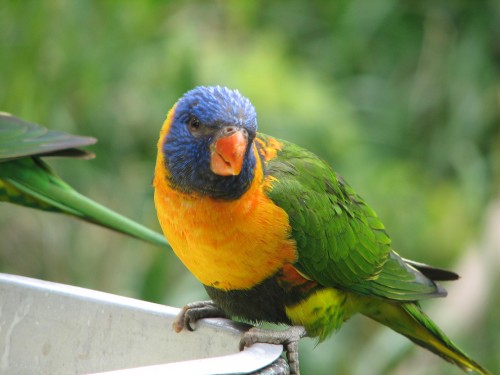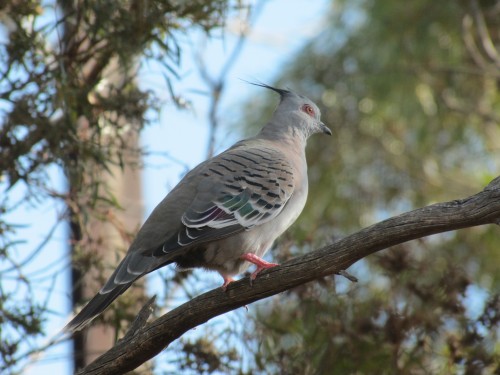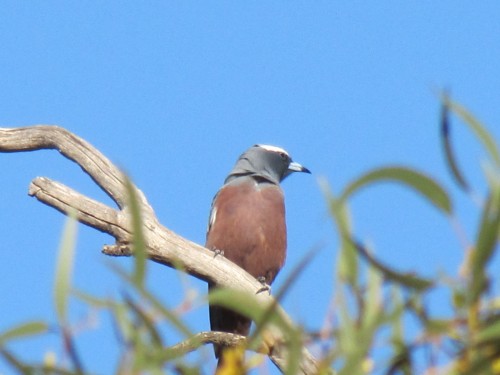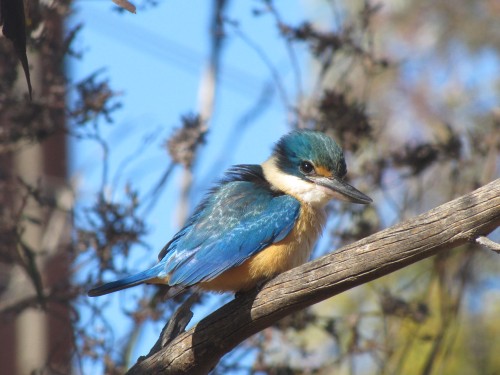Birding interrupted
My son and I were relaxing on the back lawn on Christmas afternoon. We’d had a great family Christmas lunch and were enjoying the time to relax and just talk. Both of us had our cameras at arm’s length after taking plenty of shots of the festivities.
Everyone else had migrated indoors. With the children no longer causing plenty of noise the resident Blue Tongue Lizard decided to join us. Not exactly a top birding event but very satisfying nevertheless. The birds in my son’s garden were being uncooperative anyway, so the interruption was welcome.
Bird photography runs in the family
It seems that the love of bird photography runs in the family.
My son has some new photographic gear that he loves using. On a recent visit home he proudly showed me his new equipment: a Canon EOS 40D digital SLR.
Nice camera – bit on the heavy side for my liking, but one can really get into the photo game with gear like that.
Anyway, Simon has been posting a few of his bird photos on his blog. Here are some recent posts that include bird shots:
- Munro park / Tunks Park– (north Sydney
- Parrots at Tunks – King Parrots
- Lane Cove National Park
- Kookaburra on the clothes line – a stunning close up photo
And here is where I wrote about my camera and bird photography:
Bird word: flight feathers
- Flight feathers: these are the well developed feathers on the wings and tail which are used in flight. The wing feathers consist of primaries, secondaries and tertiaries.
I have tried a number of times to capture the flight of various birds, generally with not much luck. In many cases the flight feathers show up brilliant colours or patterns not apparent when the bird is viewed sitting. I remember one attempt late last year when a number of Whiskered Terns were skimming low over us on the edge of Lake Alexandrina while we had a cuppa. For nearly an hour I tried to get a photo; only blurred images or cloud shots resulted. Very frustrating. With more time and experience – not to mention cooperative birds – I will succeed in capturing some great shots one day. In the meantime, you have to be satisfied with this photo of a Caspian Tern.
Updated November 2013.
Do I need a camera?
Frequently asked questions about birding #13
Do I need a camera when I go birding?
No.
But I guarantee you will be saying “If only I had a camera” far too many times.
I carry a small camera bag containing a small digital camera when I go birding. They are so small, light and easy to use. I’ve got so many wonderful photos over recent months that it has totally renewed my interest in photography.
A word of warning: always take spare batteries. I had a wonderful opportunity to take a photo of a rare bird once and the batteries died just a few minutes before. I now carry TWO sets of spare batteries! I’m a slow learner.
Update November 2013:
Since writing this article I have taken many thousands of photos, both here in Australia and overseas. I have included the best of them on this site. Browse through the archives for articles which might interest you; most have at least one photo. Below is a selection of just a few.
How to be a Birder part 14
Hint # 14 Use a camera
With the advent of cheap, easy to use digital cameras with great zoom facilities, bird photography has become accessible to everyone. One doesn’t need to buy big, expensive telephoto lenses to get great shots of birds. An added bonus is that you don’t have to lug around a wheel barrow load of camera equipment, lenses, tripod, flash units and other assorted gear. If that turns you on, fine. Go ahead and ruin your back. Only joking. If you want to go down the professional photographer path you probably will need a truck load of gear, but for the ordinary birder, the modern digital camera means light, compact, ease of use and great results.
When I purchased a new digital camera in the middle of 2005 I rediscovered my interest in photography. Many years ago, over 30 years ago in fact, I bought a cheap SLR. I even got to the point of developing my own slide photos. I couldn’t really afford too many extras like expensive telephoto lens, and gradually the interest waned. The digital age has reignited a passion for photography.
I bought a Canon Powershot S2 IS digital camera with a 12x zoom facility. Now this was something of compromise. I bought it especially for the trek in the Everest region I did last January (read my travel blog for details of my adventures). I wanted a powerful camera with plenty of zoom but it had to be compact. I didn’t want to carry a great deal of heavy equipment, and the Canon, while something of a compromise, was ideal.
It has proved to be amazingly adept as a great camera for bird photography. It is easy to carry, even with binoculars around my neck. I have a loop tied in the strap so that it fits over my wrist and just dangles from there when not in use. This way it doesn’t bang against my binoculars. Nor does it interfere with viewing a bird using the binoculars. It is simple and quick to use and the 12x zoom facility is brilliant.
UPDATE: The model of camera I write about above has been through a series of different models and seems to be no longer available. Several new series of models have replaced it, and prices have dropped in recent years. Check out your favourite camera shop.
Updated November 2013.







